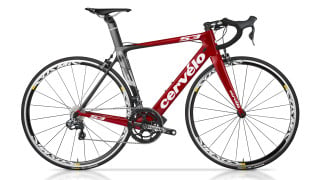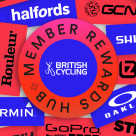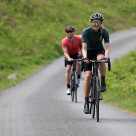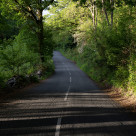Designed for covering miles of tarmac quickly, there is no doubting, especially if you have come from riding a mountain bike or a hybrid, the wonderful efficiency of a road bike. From top of range pro standard machines to entry level models, what key characteristics are common to all road bikes and what differentiates them from their trail, track and time trial cousins?
Handlebars
For many people the defining characteristic of a road bike are the drop handlebars. They facilitate a lower more aerodynamic riding style and give you the choice of three hand positions. On the flat bar-tops is good for relaxed riding, climbing in the saddle or rough road surfaces. Riding with your hands on the hoods is ideal for cruising along, climbing out of the saddle or, with wrists leant on them and hands hooked over, riding hard into the wind. The drops are there for when you want to ride hard, if you are descending or launching a sprint.
Brakes and shifters
Prior to 1990, when Shimano introduced their STI (Shimano Total Integration) system, brakes and shifters on road bikes were separate components with the shifters sited on the bike’s downtube. The brakes and shifters are now combined into an integrated unit that allows you to shift gear and control your speed whether riding with your hands on the hoods, on the drops, seated or standing out of the saddle. The exact shifting mechanism varies between manufacturers with Shimano favouring the brake lever and a paddle, Campagnolo a paddle and a thumb switch and SRAM their single paddle “double tap” system.
Which system you choose comes down largely to personal preference but, if you’ve got smaller hands, you should choose a system that allows you to adjust the reach to the levers. In the UK, the left hand lever operates the rear brake and controls shifting of the chainrings and the right hand lever the front brake and shifting of the rear cassette. On the Continent and in the States, the brakes are the other way round so beware if you hire a bike. Electronic shifting is now becoming more popular and typically the buttons are sited in similar locations to the mechanical shifters from the same manufacturer.
Frame and geometry
The most common frame materials for road bikes are alloy, steel, carbon fibre and titanium. There are advantages and disadvantages to them all but a poor quality frame is poor quality frame no matter what it is made from.
With road cycling encompassing disciplines from short, intensely fast and technical crits to day long sportives, frame geometries vary considerably. Aggressive racing bikes will tend to have steeper seat angles and shorter head tubes and, although such bikes can deliver startling performance and handling in the right hands, if you are fairly new to the sport or targeting sportives a more relaxed geometry erring towards comfort and stability will be preferable. Increasingly higher end road bike frames are prioritising aerodynamic performance and adopting many features, such as deep profiled tubing, hidden brakes and wheel hugging seat tubes, more typically found on time trial bikes. Talk to your local bike shop and more experienced riders, be honest about your experience and riding intensions and find a frame that is suited to you.
Drillings
All road bikes will have drillings for two bottle cages but not all will have drillings for mudguards or panniers. If you are intending to commute on your road bike or use it to log winter miles, make sure it has the drillings you require.
Gearing
Modern road bikes will typically have two chainrings combined with a rear cassette offering 9, 10 or 11 sprockets. The standard racing set-up was typically 53/39t chainrings with an 11-25t cassette but compact (50/34t) and semi-compact (52/36t) chain-sets paired with wide 11-28t or even 32t cassettes are becoming popular even amongst professional riders.
As with frame geometry, it’s a good idea to talk to your local bike shop and they should be able to advise you on the most appropriate gearing for your riding requirements.
Pedals
Clipless pedals, where a cleat on your shoes attaches to the pedals, offer the most efficient pedalling system on the road. Although the idea of being attached to your bike might appear daunting, releasing your feet is easy and soon becomes second nature. In general road clipless pedals have one-sided engagement, as opposed to two or even four sided on mountain biking pedals, and have a wider platform to spread out the more constant pressure.
Wheels
Wheels have a significant effect on how a bike performs and handles and as manufacturers, even on fairly high end bikes, tend to spec fairly low quality wheelsets, they are often one of the first components that you will upgrade. Although deeps section carbon wheels look great and ride brilliant, for commuting, winter riding, sportives and training miles, you can’t go far wrong with a decent set of handbuilt standard section alloy wheels.
Tyres
Apart from at the highest levels of the sport where tubulars are still used, clincher tyres with an inner tube are most popular on the road. However tubeless clincher set-ups are becoming increasingly commonplace. Tyre choice is always a trade-off between performance and durability. Super lightweight tyres might feel great and save you a few seconds but they also may cost you minutes as they are more prone to punctures.
Tyre width is another decision to make, with road tyres typically varying between 19mm and 30mm. Where hard and narrow was always thought to be faster, increased understanding of rolling resistance and the aerodynamic interaction between tyre and rim has made wider, 25-28 mm, tyres run at lower pressures more popular. If you do decide to go wide, make sure your frame has enough clearance.


















